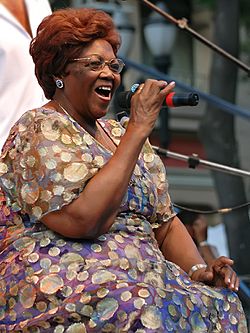Dona Ivone Lara facts for kids
Quick facts for kids
Dona Ivone Lara
|
|
|---|---|
 |
|
| Background information | |
| Birth name | Yvonne Lara da Costa |
| Born | April 13, 1921 Rio de Janeiro, Brazil |
| Died | April 16, 2018 (aged 96) Rio de Janeiro, Brazil |
| Genres | Samba |
| Occupation(s) | Singer, composer, nursing |
| Instruments | vocals |
| Years active | 1970–2018 |
Yvonne Lara da Costa (born April 13, 1921 – died April 16, 2018), known as Dona Ivone Lara, was a famous Brazilian singer and composer. She was a true pioneer in the world of samba music. Dona Ivone became the first woman to join the important composers' wing of a samba school. This made her a legend in Brazilian music.
Contents
Dona Ivone Lara's Early Life and Music Journey
Dona Ivone Lara was born as Yvonne Lara da Costa in Rio de Janeiro, Brazil. She faced challenges early in life. Her mother passed away when she was three, and her father died when she was twelve.
She was then raised by her aunts and uncles. It was with them that she first learned to play the cavaquinho, a small string instrument. She grew up surrounded by samba music, learning from her cousin, Mestre Fuleiro. She even took singing lessons from Lucília Villa-Lobos and was praised by her husband, the famous Brazilian composer Heitor Villa-Lobos.
Dona Ivone's Career in Nursing
Before becoming a full-time musician, Dona Ivone had another important career. She studied nursing and specialized in Occupational Therapy. She worked as a social worker, helping people in psychiatric hospitals. There, she met and worked with Nise da Silveira, a well-known psychiatrist. Dona Ivone retired from nursing in 1977.
Becoming a Samba Pioneer
When she was 25, Dona Ivone married Oscar Costa. His father, Alfredo Costa, was the president of the Prazer da Serrinha samba school. A samba school is like a community group that prepares for the big Carnaval parades.
At Prazer da Serrinha, Dona Ivone met many composers. Some of them, like Mano Décio da Viola and Silas de Oliveira, later became her partners in writing songs. She composed the samba song Nasci para sofrer (Born To Suffer). This song became the special theme for the samba school.
In 1947, the Império Serrano samba school was created. Dona Ivone began to parade with the ala das baianas (Wing of the Baianas) during Carnaval. She also composed another samba called Não me perguntes (Don't Ask Me).
Her biggest moment as a composer came in 1965. She wrote Os cinco bailes da história do Rio (The Five Balls of the History of Rio). With this song, she made history! She became the first woman ever to join the ala de compositores (Wing of the Composers) of a samba school. This was a huge achievement for women in samba.
Musical Career and Legacy
After retiring from nursing in 1977, Dona Ivone dedicated herself completely to music. She continued to record albums and perform live for audiences. Many famous singers and artists have performed her songs. These include Clara Nunes, Roberto Ribeiro, Maria Bethânia, Caetano Veloso, Gilberto Gil, Paula Toller, Paulinho da Viola, Beth Carvalho, Mariene de Castro, and Roberta Sá. Her music continues to inspire many people.
Dona Ivone Lara's Discography
Dona Ivone Lara released many albums during her career. Here are some of them:
- 1970 – Sambão 70
- 1972 – Quem samba fica?
- 1974 – Samba minha verdade, minha raiz
- 1979 – Sorriso de criança
- 1980 – Serra dos meus sonhos dourados
- 1981 – Sorriso negro
- 1982 – Alegria minha gente
- 1985 – Ivone Lara
- 1986 – Arte do encontro (with Jovelina Pérola Negra)
- 1998 – Bodas de ouro
- 1999 – Um natal de samba (with Délcio Carvalho)
- 2001 – Nasci para sonhar e cantar
- 2004 – Sempre a cantar (with Toque de Prima)
See also
 In Spanish: Dona Ivone Lara para niños
In Spanish: Dona Ivone Lara para niños
- Liga Independente das Escolas de Samba do Rio de Janeiro

